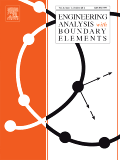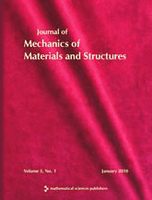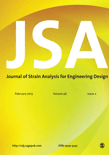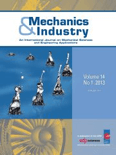
ACTA MECHANICA
Scope & Guideline
Transforming Ideas into Mechanical Solutions
Introduction
Aims and Scopes
- Nonlinear Dynamics and Vibrations:
The journal consistently publishes research on nonlinear dynamics, including vibration analysis of various structures such as beams, plates, and shells, often incorporating advanced materials like functionally graded materials (FGMs) and piezoelectric elements. - Thermoelasticity and Heat Transfer:
A significant portion of the research addresses thermoelastic phenomena, heat transfer mechanisms, and their implications in materials under thermal and mechanical loading, utilizing both analytical and numerical methods. - Computational Mechanics and Machine Learning:
ACTA MECHANICA includes studies that leverage computational methods, including finite element analysis and machine learning techniques, for solving complex engineering problems and enhancing predictive modeling. - Multiscale and Micromechanics:
The journal features research on multiscale modeling and micromechanical analysis, particularly in relation to nanomaterials and composites, focusing on the interactions between microstructural features and macroscopic properties. - Applied Mechanics and Engineering Solutions:
It also emphasizes applied mechanics, providing solutions to practical engineering challenges, particularly in the areas of structural dynamics, material behavior, and system optimization.
Trending and Emerging
- Advanced Materials and Smart Structures:
There is a significant uptick in research involving advanced materials, such as piezoelectric, magnetostrictive, and functionally graded materials, particularly in the context of smart structures that can adapt to their environment. - Computational Intelligence and Machine Learning:
The integration of machine learning and artificial intelligence techniques in mechanical analysis and predictive modeling has gained momentum, leading to innovative approaches in damage detection and optimization. - Nonlinear and Complex Systems Analysis:
An increasing number of studies focus on the nonlinear behavior of complex systems, including bifurcation analysis and dynamic stability, indicating a shift toward understanding intricate mechanical phenomena. - Thermal and Coupled Field Problems:
Research addressing coupled thermal and mechanical effects, particularly in materials subjected to extreme conditions, is becoming more prevalent, reflecting the need for comprehensive analyses in engineering applications. - Environmental and Sustainability Considerations:
Emerging themes also include sustainability in materials and mechanics, with studies focusing on the environmental impact of mechanical systems and the development of eco-friendly materials.
Declining or Waning
- Traditional Elasticity Studies:
There has been a noticeable decrease in the publication of papers focused solely on classical elasticity theories, as researchers increasingly explore more complex material behaviors and advanced modeling techniques. - Simplistic Approaches to Dynamics:
Research employing overly simplistic models for dynamic analysis, without considering factors such as material heterogeneity or nonlinear effects, has become less frequent as the demand for more accurate and realistic modeling increases. - Static Analysis of Structures:
The focus on static analysis as a standalone topic has waned, with a growing trend toward dynamic analysis and the incorporation of time-dependent factors in structural assessments.
Similar Journals

ENGINEERING ANALYSIS WITH BOUNDARY ELEMENTS
Advancing the Frontiers of Engineering AnalysisEngineering Analysis with Boundary Elements is a premier journal dedicated to the rapid dissemination of innovative research in the fields of engineering, applied mathematics, and computational mathematics. Published by Elsevier Science Ltd, this journal has established itself as a significant contributor to the academic community since its inception in 1989, continuing to publish cutting-edge findings through 2024. With an impressive Q1 ranking in Engineering (miscellaneous) and Q2 rankings in Analysis, Applied Mathematics, and Computational Mathematics, it is recognized for its rigorous peer-review process and high-quality content, as evidenced by its competitive Scopus rankings. The journal aims to foster interdisciplinary collaboration and advance knowledge in boundary element methods while offering insights into contemporary challenges facing engineers and mathematicians. Researchers, professionals, and students will benefit from its comprehensive approach, access to pivotal studies, and a platform for sharing their discoveries. Although not an open-access journal, it provides substantial value to anyone engaged in the dynamic intersection of engineering and mathematics.

Journal of Computational Applied Mechanics
Advancing the Frontiers of Computational MechanicsJournal of Computational Applied Mechanics, published by UNIV TEHRAN, DANISHGAH-I TIHRAN, is an influential open-access journal that has been disseminating significant research findings since its inception in 2012. With a dedicated focus on the fields of Computational Mechanics, Mechanical Engineering, and Mechanics of Materials, this journal has garnered a Q3 ranking in multiple relevant categories as of 2023, indicating its burgeoning impact within the academic community. Although precise HIndex scores are currently unavailable, the journal's recognition is underscored by its Scopus rankings, placing it in the middle tier among its peers. The journal invites researchers, professionals, and students to contribute to and engage with the continually evolving discourse in applied mechanics, fostering innovation through the dissemination of quality research. As an open-access journal, it ensures that findings are readily accessible to a global audience, thereby enhancing collaboration and knowledge sharing in the scientific community.

FINITE ELEMENTS IN ANALYSIS AND DESIGN
Pioneering research in analysis and design.FINITE ELEMENTS IN ANALYSIS AND DESIGN, published by Elsevier, is a leading international journal dedicated to advancing the field of engineering analysis using finite element techniques. With a strong focus on theoretical and applied contributions, the journal spans a broad spectrum of subjects, including structural analysis, computational mechanics, and computer graphics applications, making it an essential resource for researchers, professionals, and students alike. As evidenced by its impressive Q1 ranking in multiple categories, including Analysis and Computer Graphics, and its Scopus rankings placing it in the top 10% across several fields, it serves as a vital platform for disseminating cutting-edge research and innovative applications within the field. The journal, with an ISSN of 0168-874X and an E-ISSN of 1872-6925, publishes articles that emphasize rigorous mathematical methodologies and computational advancements, ensuring high relevance for contemporary engineering challenges. With a history extending from 1985 to 2024, it continues to shape the discourse and progress within the finite element community.

Moscow University Mechanics Bulletin
Empowering Ideas in Mathematics and MechanicsMoscow University Mechanics Bulletin, published by PLEIADES PUBLISHING INC, is a dedicated journal that has been influencing the fields of mechanical engineering and mechanics since its inception. With an ISSN of 0027-1330 and E-ISSN of 1934-8452, this journal serves as a crucial platform for advancing knowledge in mathematics, mechanical engineering, and mechanics of materials. Though currently indexed in the Q4 category across these disciplines, it offers a unique space for researchers and professionals to engage with emerging theories, experimental results, and practical applications. With a converged publication history spanning from 1973 to 1987, and continuing from 2007 to 2024, the journal remains relevant in today’s academic landscape. Though it operates under traditional access models, the journal's global reach aims to connect diverse voices in engineering research. Aspiring researchers and seasoned professionals alike will find valuable insights and a robust discourse that contribute to their respective fields.

Journal of Mechanics of Materials and Structures
Fostering Academic Excellence in Material Behavior Research.Journal of Mechanics of Materials and Structures, published by Mathematical Science Publishers, is a distinguished periodical in the field of Applied Mathematics and Mechanics of Materials. With the ISSN 1559-3959, this journal has been a pivotal platform since its inception in 2006, providing insights and advancements in the mechanics of materials and their structural applications. Operating out of the University of California, Berkeley, this journal not only boasts a respectable standing within its categories, ranking Q4 in Applied Mathematics and Q3 in Mechanics of Materials as of 2023, but it also serves a crucial role in fostering academic discourse among researchers, practitioners, and students alike. Although it does not currently offer open access, its contributions to the respective fields are invaluable, underscoring the relevance and importance of continued research in understanding material behavior and structural integrity. Whether investigating theoretical frameworks or engineering applications, the Journal of Mechanics of Materials and Structures remains an essential resource for anyone dedicated to the advancement of the science of materials and structures.

JOURNAL OF STRAIN ANALYSIS FOR ENGINEERING DESIGN
Transforming Engineering Design with Cutting-Edge Strain Analysis.The Journal of Strain Analysis for Engineering Design, published by SAGE Publications Ltd, is a prestigious academic journal that has been at the forefront of *engineering and applied mathematics* research since its inception in 1965. With a focus on the intricate analysis of strain in engineering design, this journal serves as a vital resource for researchers and professionals seeking to push the boundaries of understanding in mechanics and materials engineering. As of 2023, it enjoys a respectable ranking in its respective fields, including Q2 in *Mechanical Engineering* and *Mechanics of Materials*, and Q3 in *Applied Mathematics* and *Modeling and Simulation*, reflecting its significant contribution to the academic community and relevance in practical applications. Although it is not an open-access journal, its rigorous peer-review process ensures the dissemination of high-quality research. The journal provides a platform for innovative ideas and methodologies, fostering advancements in engineering design and analysis vital for both academia and industry. By bridging theoretical foundations with real-world applications, the Journal of Strain Analysis for Engineering Design remains an essential publication for those dedicated to addressing the complexities of modern engineering challenges.

MECCANICA
Bridging Disciplines in Physics and Mechanical EngineeringMECCANICA, an esteemed journal published by Springer, stands at the forefront of research in the fields of Condensed Matter Physics, Mechanical Engineering, and Mechanics of Materials. Established in 1966 and continuing through 2024, this journal provides a robust platform for the dissemination of innovative research and advancements in these increasingly interconnected domains. With an impressive 2023 ranking placing it in the Q2 category across multiple fields, MECCANICA boasts a Scopus rank of #198 in Mechanical Engineering, #150 in Condensed Matter Physics, and #141 in Mechanics of Materials, highlighting its significance and influence within the scholarly community. The journal aims to foster dialogue among researchers, professionals, and students, facilitating the exchange of cutting-edge ideas and methodologies crucial for overcoming contemporary engineering and physics challenges. Readers can access a wealth of knowledge through its comprehensive articles, and while it does not currently offer open access, the journal remains instrumental in shaping the future of engineering and physical sciences.

Mechanics & Industry
Shaping the Future of Mechanics and ManufacturingMechanics & Industry, published by EDP SCIENCES S A, is a prominent open access journal dedicated to the fields of Industrial and Manufacturing Engineering, Materials Science, and Mechanical Engineering. Since its establishment in 2004, the journal has served as a crucial platform for disseminating innovative research and developments in mechanics, catering to a diverse audience of researchers, professionals, and students worldwide. With an ISSN of 2257-7777 and an E-ISSN of 2257-7750, the journal is indexed in Scopus and has achieved a respectable Q3 quartile ranking across its categories for 2023. Mechanics & Industry emphasizes the importance of collaborative research and the sharing of knowledge, underpinning advancements in technology and industry practices. The journal's commitment to open access ensures that research findings are available to all, promoting sustainability and innovation within the global engineering community. Located in Les Ulis, France, this journal continues to uphold high standards of scholarly excellence and relevance in an ever-evolving industrial landscape.

CONTINUUM MECHANICS AND THERMODYNAMICS
Unveiling the Complexities of Materials and Energy DynamicsCONTINUUM MECHANICS AND THERMODYNAMICS is a prestigious academic journal published by Springer, focusing on the interdisciplinary fields of mechanics, materials science, and thermodynamics. With an ISSN of 0935-1175 and E-ISSN 1432-0959, this journal serves as an essential platform for researchers and practitioners to disseminate innovative findings and methodologies that advance theoretical and practical applications in these pivotal areas of science. Operating from Germany, this journal has gained significant recognition, achieving a Q2 quartile ranking in multiple categories, including Materials Science and Mechanics of Materials, as noted in the 2023 metrics. With Scopus rankings highlighting its competitive standing—ranked #65 in General Physics and Astronomy and #118 in Mechanics of Materials—CONTINUUM MECHANICS AND THERMODYNAMICS is committed to publishing high-quality, peer-reviewed research that fosters knowledge exchange and drives progress. While it currently does not offer Open Access, this journal remains a vital resource for those committed to exploring the complexities of continuum mechanics and thermodynamic processes.

Coupled Systems Mechanics
Pioneering Research in Mechanics of MaterialsCoupled Systems Mechanics is a pioneering journal in the fields of Civil and Structural Engineering and Mechanics of Materials, published by TECHNO-PRESS. With an ISSN of 2234-2184 and an E-ISSN of 2234-2192, this journal actively contributes to the academic discourse surrounding coupled system mechanics, addressing complex interactions within engineering disciplines. Hailing from South Korea, the journal has been committed to disseminating high-quality research since its inception, converging years from 2017 to 2024. It holds a respectable Q3 ranking in both Civil and Structural Engineering and Mechanics of Materials, indicating its relevance and impact within these fields. Researchers, professionals, and students can expect cutting-edge studies and innovative methodologies, as the journal consistently aims to enhance understanding and application of coupled systems in engineering. Although it operates under a subscription model, it remains an essential resource for those looking to stay at the forefront of advancements in engineering sciences.